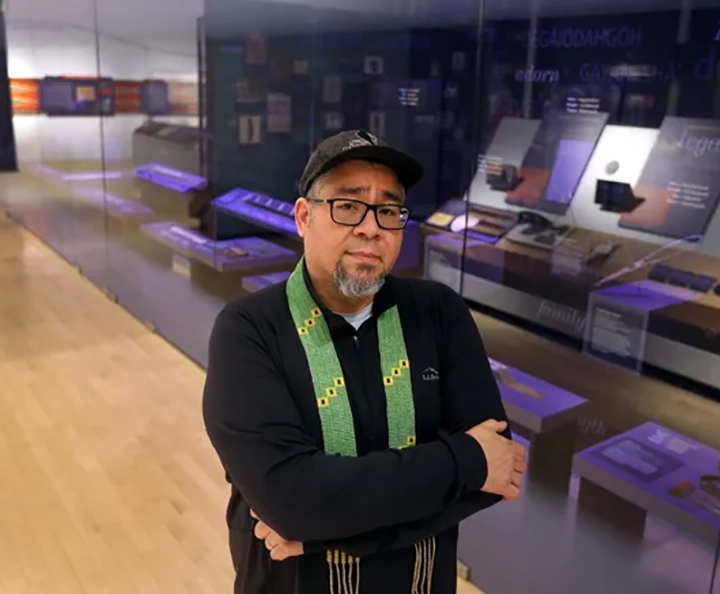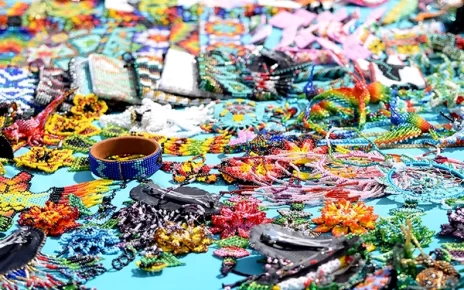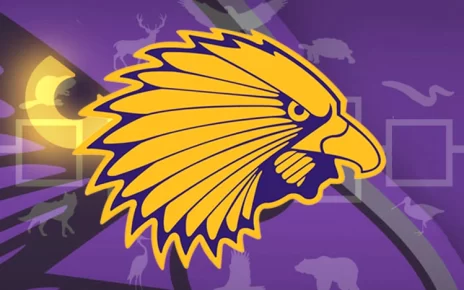April 14, 2023 | By Justin Murphy | Rochester Democrat and Chronicle (democratandchronicle.com)
Pictured above: Michael Galban is the historic site manager of Ganondagan and curator of the Seneca Art and Culture Center.Photo credit: Jamie Germano/D&C
Hundreds of years after they were given as gifts to Europeans by Indigenous people of the Northern Woodlands, a collection of wampum belts, beads and artifacts are again in traditional Haudenosaunee territory as part of a path-breaking partnership between a famed Parisian museum and the Seneca Art and Cultural Center at the State Historic Site at Ganondagan.
The exhibition, called WAMPUM/OTGOÄ, runs at Ganondagan until Sept. 16, after which it will go to the McCord Stewart Museum in Montreal and then back to its home, the Musée du Quai Branly in Paris (otgoä is the Seneca word for wampum). It marks a rarity in the world of ethnographic museums: a respectful collaboration between a European institution with Indigenous artifacts in its collection and an Indigenous-led museum in the place where the artifacts originated.

It was spearheaded by Michael Galban, an expert in the material culture of Northern Woodlands people, including the Haudenosaunee, and the curator of the Seneca Art and Cultural Center. He works at the intersection of art, anthropology and history, studying the physical objects created by Indigenous people in Great Lakes and Atlantic coast regions and attempting to understand then re-create the processes they used.
“There’s a history that’s not well understood because people don’t have access to their cultural objects, because a lot of them are in museums, especially in Europe,” he said. “My goal is to take those historic artifacts and regain the knowledge of how to create them, to restore that connection to our history.”
Several years ago, he consulted on a major exhibition of Haudenosaunee artifacts for a museum in Germany. It was well researched and thoughtfully mounted — but almost no Haudenosaunee people got a chance to see it.
“I just thought, ‘What is the point?'” he said. “It’s like: ‘We have all your stuff and we know all about it, but you don’t have access to it.'”
In 2020, when the Musée du Quai Branly in Paris contacted him to help with a wampum exhibit, he agreed with a condition. He would only help with the Parisian project if he could bring it to Ganondagan as well.
His French counterparts not only agreed, but helped Ganondagan secure more than $250,000 in grant funding to make it happen.
Diplomatic Gifts
Collections from indigenous people or formerly colonized places are often fraught with controversy over how objects were procured — mummies robbed from Egyptian tombs, for instance, or priceless gems forcibly taken. That is not the case with the wampum at the Musée du Quai Branly; it was given freely to Europeans as gifts or for diplomatic purposes, mostly in the 18th century.
For instance, one striking wampum belt inscribed to the Virgin Mary was created by newly converted Huron-Wendat people and given to a French church as a religious offering.
Once in Europe, the items often then circulated among the wealthy or those with a particular interest in indigenous artifacts.

“Bringing back objects to fill your cabinets, to show your worldliness, to impress your dinner guests — that was a big thing at the time,” Galban said.
The actual beads of purple quahog and white whelk shell likely span more than 200 years, displaying the evolution of techniques that indigenous people used to create them. Some are woven into belts while others hang in strings or are embedded into other objects.
Each piece is mounted with a simple text display showing three or four words in English, Seneca and French, explaining the general significance of the wampum in that particular context. A war club dating from around 1700, for instance, has words including strength (ga’háshdeshä’) and protect (dewë’nyadö’).
As artwork, the display is dazzling — but that is not its primary purpose. Instead, Ainsley Jemison, cultural liaison at Ganondagan, said the goal was more profound: “Let wampum do what wampum does.”
Welcoming Ceremony
Many of the other indigenous tribes represented in the exhibit were enemies of the Seneca at the time the artifacts were created. Inviting them to Ganondagan to see the items, then, required an air-clearing of sorts.
Before the exhibit was even unpacked from the shipping crates, Galban invited representatives from other nations, Haudenosaunee and otherwise, to come to Ganondagan. They held a version of a ceremony called Edge of the Woods that has not been conducted in more than 300 years, Galban and Jemison said. Its purpose is to welcome foreign visitors and establish peaceful relations.

“We felt the importance of holding these things in relationship, because they’re still a part of our culture,” Jemison said. “So we had to pay them our respect and welcome them home.”
Similarly, the last time the French government concerned itself with Ganondagan was in 1687, when the Marquis de Denonville destroyed the village in a raid. The new relationship with the Musée du Quai Branly, Galban said, is the model for a different relationship grounded in mutual respect.
“You can see the role that wampum played for our ancestors, including the Haudenosaunee people in the first days of colonialization,” he said. “Now it’s being given a chance to do the job it was intended to do: to create relationships, to form alliances and to heal.”
WAMPUM/OTGOÄ will run at Ganondagan until Sept. 16, after which it will go to Montreal and then back to France. The Musée du Quai Branly has already begun to explore similar relationships with other indigenous-led museums, and Galban said he hopes to organize exhibits at Ganondagan in the future.




